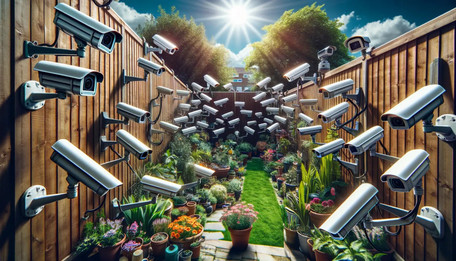Architecture Privacy Strategies: Erecting Boundaries Against Surveillance in Smart Cities
28th Jul 2024
"In George Orwell's seminal work, 1984, published in 1949, the concept of being perpetually monitored was not just a narrative device but a stark warning against the encroachments of a surveillance-heavy state. Fast forward more than seven decades, and the prescient concerns of Orwell's dystopian universe seem to be materializing in our own, with architecture privacy now at the forefront of the conversation. As cities evolve into 'smart' hubs, the balance between safety and individual privacy is increasingly challenged, necessitating a reevaluation of architecture privacy principles.
Orwell's depiction of a world where every action is subject to scrutiny seems less fictional today as we navigate the complexities of modern urban living. The demand for safer cities, driven by various global insecurities, has led to the widespread adoption of surveillance technologies. Yet, this push for security often infringes upon architecture privacy, leading to a delicate dilemma: How can we maintain safety without sacrificing the sanctity of personal privacy?
The proliferation of CCTV and other monitoring technologies in metropolises like London, Beijing, Singapore, and New York has sparked significant debate. Critics argue that while these measures are often justified with crime prevention rhetoric, they also pose serious threats to architecture privacy and civil liberties. The concept of architecture privacy is not just about resisting surveillance but about designing spaces that respect individual freedoms and promote equitable social dynamics.
Amid these concerns, the role of architecture privacy becomes paramount. Innovative design strategies that prioritize privacy can mitigate the intrusive nature of surveillance technologies. For instance, the integration of materials and design elements that counteract monitoring tools—such as anti-reflective coatings or infrared-blocking materials—demonstrates how architecture privacy can be woven into the very fabric of our urban environments.
Moreover, the strategic planning of city layouts and the incorporation of privacy-focused urban design are critical in fostering environments where architecture privacy is preserved. By creating spaces that naturally limit surveillance—through winding streets, varied building heights, and dense greenery—architects and urban planners can champion architecture privacy while still catering to the aesthetic and biodiversity needs of a city.
As we delve deeper into the age of Smart Cities, the emphasis on architecture privacy extends to digital realms. Secure communication infrastructures, including encrypted Wi-Fi networks and data protection measures, are essential components of architecture privacy. These technologies protect against digital surveillance and data breaches, underscoring the multifaceted approach required to safeguard privacy in modern urban settings.
In conclusion, the dialogue around surveillance, security, and privacy is evolving, with architecture privacy at its core. The challenge lies in crafting urban spaces that respect personal freedoms while addressing security needs—a task that requires innovative design, thoughtful urban planning, and a commitment to safeguarding the digital and physical realms. As we navigate this complex landscape, architecture privacy emerges not just as a design principle but as a fundamental human right, critical to the creation of equitable and livable cities in the 21st century."
View our indoor and outdoor artificial screening trees.
Architecture privacy strategies
Architecture privacy strategies are essential in designing buildings and urban spaces that respect the privacy needs of individuals while accommodating the demands of modern living and community interaction. These strategies are deployed across various scales, from urban planning to interior design, ensuring that privacy considerations are integrated throughout the development process. Here are some key strategies:
Urban Planning and Layout
- Buffer Zones: Creating buffer zones between public and private areas can significantly enhance privacy. This can include landscaping, parks, or water bodies that physically separate spaces without creating a sense of isolation.
- Strategic Orientation and Placement: The orientation and placement of buildings can be optimized to minimize unwanted views into private areas. For example, aligning windows and balconies to face away from neighboring buildings or public spaces can help protect visual privacy.
- Density Management: Managing the density of developments can balance the need for community interaction and private spaces. Lower density areas can offer more private space per dwelling, while higher density can be managed with design to still afford privacy.
Architectural Design
- Zoning and Layout: Within buildings, creating clear zones for public and private activities helps manage privacy. For example, placing living areas towards the back of a home and service areas towards the front can shield private activities from public view.
- Visual Barriers: Strategic use of walls, fences, screens, and landscaping can provide visual privacy from neighbors and public areas. Materials and designs can be chosen to complement the architectural style while serving the privacy needs.
- Window Placement and Treatments: The placement of windows, skylights, and other openings can be designed to optimize natural light while minimizing exposure. Frosted glass, smart glass, and other treatments can offer control over visibility.
Technology and Innovation
- Smart Glass: Glass that can change from transparent to opaque with the flip of a switch or the tap of an app allows for instant privacy control, blending modern technology with architectural design.
- Sound Insulation: Advanced materials and design techniques can minimize sound transmission between units in multi-family buildings or between different areas within a single home, addressing auditory privacy.
- Surveillance and Security Systems: While enhancing security, these systems must be designed to respect privacy, both for occupants and neighbors. This includes careful placement of cameras and consideration of what is monitored.
Landscaping and Natural Elements
- Strategic Planting: Trees, shrubs, and hedges can provide an effective and natural barrier that enhances privacy while adding aesthetic value to the space. The choice of plant species and their placement is crucial.
- Water Features: Water bodies or features can act as natural sound barriers, absorbing noise and creating a peaceful, private atmosphere. They also serve as a physical barrier, enhancing privacy in outdoor spaces.
Interior Design
- Flexible Spaces: The use of movable walls, screens, and furniture can allow spaces to be reconfigured for different levels of privacy as needed, adapting to various activities and times of day.
- Lighting Design: Careful design of lighting can influence perceptions of space and privacy. For example, more intimate, lower lighting can create a sense of privacy even in more open-plan areas.
Community Integration
- Shared Spaces: Designing shared spaces with privacy in mind can encourage community interaction while respecting individual privacy. This includes communal areas in residential buildings or shared outdoor spaces in neighborhoods.
- Accessibility and Visibility: Ensuring that public areas are accessible and visible can enhance security (natural surveillance) while private spaces remain secluded.
Sustainability and Privacy
- Eco-friendly Privacy Solutions: Incorporating sustainable design elements such as green roofs or living walls not only provides privacy but also contributes to the building's environmental performance.
- Natural Ventilation: Designing for natural ventilation can reduce the need for mechanical systems, preserving privacy by minimizing noise and the intrusion of equipment into private spaces.
Ethical and Legal Considerations
- Data Privacy: In an era where smart homes and buildings are increasingly common, protecting the digital privacy of occupants through secure networks and data protection measures is crucial.
- Regulations and Standards: Compliance with local zoning laws, building codes, and privacy regulations ensures that architectural privacy strategies are legally sound and ethically responsible.
Conclusion
Architecture privacy strategies are a multidisciplinary approach, blending art, science, technology, and social considerations to create spaces that respect individual privacy while fostering community and connection. By thoughtfully integrating these strategies into the design process, architects and planners can craft environments that balance the often competing demands of modern life, ensuring spaces are not only functional and aesthetically pleasing but also private and secure.



